Introduction: The significance of programming education in early childhood education and care
The "Course of Study for Kindergartens" (published by the Ministry of Education, Culture, Sports, Science and Technology ("MEXT"), 2017) and "How children should grow up by the end of early childhood" (MEXT, 2016) together describe some specific skills that may nurture the foundation of computational thinking. More specifically, the former promotes "the development of thinking skills such as comparison, association, and generalization through specific activities," while the latter promotes "the development of thinking skills, interest in quantities, figures and letters, and sound sentiments and expressions through childcare practices." These skills are set as educational targets. Despite the indication of the skills that can develop a foundation of computational thinking, these guidelines do not suggest any specific measures or methodologies. We believe that it is essential to establish childcare practices that can develop a foundation of computational thinking as one of the childcare methodologies to nurture children's ability to think. This is also consistent with the educational targets advocated by MEXT in its "Course of Study for Kindergartens" and "How children should grow up by the end of early childhood."
Current conditions of programming education in early childhood education and care
As explained above, there is no description of computational thinking in the "Course of Study for Kindergartens." This means that the government does not provide any specific definitions of skills and childcare practices necessary for computational thinking. In addition, there were no sufficient preceding examples and studies relating to such childcare at the beginning of 2018, when we started this study. Therefore, we first did research regarding the skills to be developed for computational thinking in early childhood education and care (Noguchi & Hotta, 2018a) and how to evaluate such skills (Noguchi & Hotta, 2018b; Noguchi, Hotta & Matsu, 2018). In this report, we will first introduce a summary of the findings of these studies, and then explain the results of programming education experiments in early childhood education and care. From now on, I will refer to computational thinking in early childhood education and care as the "foundation of computational thinking" in order to differentiate it from the general concept of computational thinking.
Skills associated with the foundation of computational thinking
Table 1 shows the definition of four skills associated with the foundation of computational thinking (Noguchi & Hotta, 2018a).
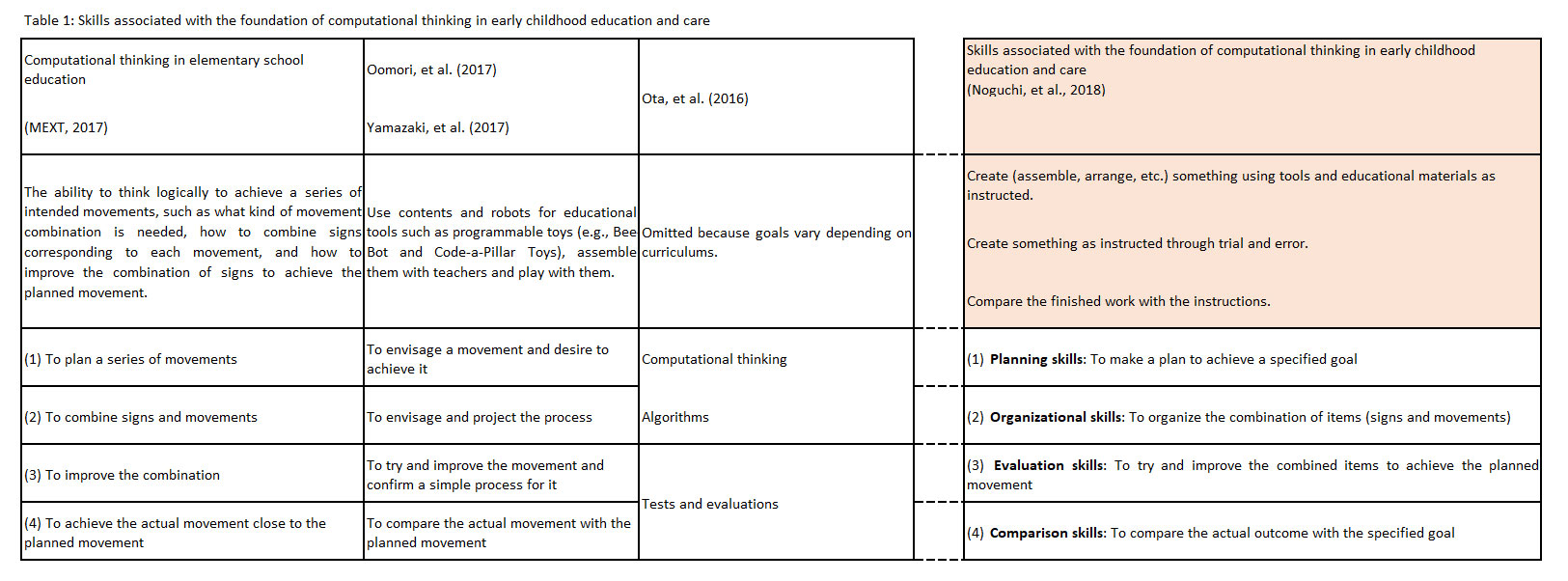
These skills are common to 1) the definition of computational thinking in elementary school education (MEXT, 2017), 2) the definition of programming activities in early childhood education and care based on the curriculums of information education in junior high and high school argued by Yamazaki, et al. (2017) and Oomori, et al. (2017), and 3) the curriculums of programming education in the UK, Australia, and the US introduced by Ota, et al. (2016).
- Planning skills are to understand a specified goal and make a plan to achieve the goal.
- Organizational skills are to organize the combination of items (signs and movements) to achieve the goal.
- Evaluation skills are to try and improve the combined items to achieve the goal and the planned movement.
- Comparison skills are to compare the specified goal with the actual outcome and find out what to improve.
Although we defined four skills associated with the foundation of computational thinking, these definitions are not enough to assess the development of young children, such as what they will be able to do and what they still cannot do. The assessment here does not mean to compare a child with other children to determine his/her superiority or inferiority, but is intended to understand changes in the abilities of the child (MEXT, 2010) as well as to determine the appropriateness of teachers' involvement and surrounding environments. There is a rubric that can be used as one of the methodologies to assess the development of children. A rubric is a type of performance assessment matrix that provides scaled achievement levels and performance characteristics according to each scaled level (Nishioka & Tanaka, 2009).
Development of a rubric to assess four skills associated with the foundation of computational thinking
I determined to develop a rubric for the assessment of the four skills associated with the foundation of computational thinking. At the beginning of April 2018, I hosted a workshop to create a rubric to assess the development of the four skills. The participants in the workshop were seven kindergarten teachers from Manabigaoka Kindergarten at Sonoda Women's University in Hyogo Prefecture. The kindergarten sets the development of children's foundation of computational thinking as one of its educational goals, and has been actively engaged in this challenge since 2018.
In the workshop, I asked the participant teachers to submit their opinions using the following three steps regarding the two questions of "What kinds of abilities are required to perform a task leveraging the four skills?" and "At what level is a child required to accomplish the task?"
- Obtaining opinions about skills: I asked the participant teachers to freely write down on a notepad their answers to the question "What kinds of skills should children acquire in early childhood education and care, which will nurture the foundation of computational thinking?" Because the kindergarten accepts children aged three to five years old, the answers of these teachers may vary depending on the age of children they are considering when they answer the question. Therefore, I specifically asked them to consider children in the five-year-old class of kindergarten when answering the question.
- Aggregating opinions: The seven participating teachers were divided into two groups (a group of three teachers and a group of four teachers) and asked them to share their answers. I got them to thoroughly discuss their answers and aggregate opinions by consolidating similar opinions.
- Setting achievement levels: Finally, I asked the participating teachers to set three achievement levels of "Well achieved," "Achieved" and "Not achieved" for children in the five-year-old class of kindergarten based on the aggregated opinions.
After taking the three steps listed above, the opinions of the two groups were summarized. I shared the results with the coauthor Hotta and checked whether there was a large discrepancy between the summarized opinions and the original opinions. We also checked the appropriateness of expressions and made corrections where necessary (Noguchi & Hotta, 2018b). For example, we consolidated the similar opinions of "the ability to remember," "the ability to think" and "the ability to project" for planning skills, and set the skill of "being able to plan procedures and methods based on given data." We used the same approach to consolidate other criteria and achievement levels. We also asked the participant teachers to check whether the consolidated criteria and achievement levels were not different from their opinions, and made additions and corrections where necessary. As a result, we extracted 34 rubric assessment items (eleven items for planning skills; eight items for organizational skills; six items for evaluation skills; and nine items for comparison skills) as well as three achievement levels from the opinions of the participant teachers (Table 2; Noguchi & Hotta, 2018b).
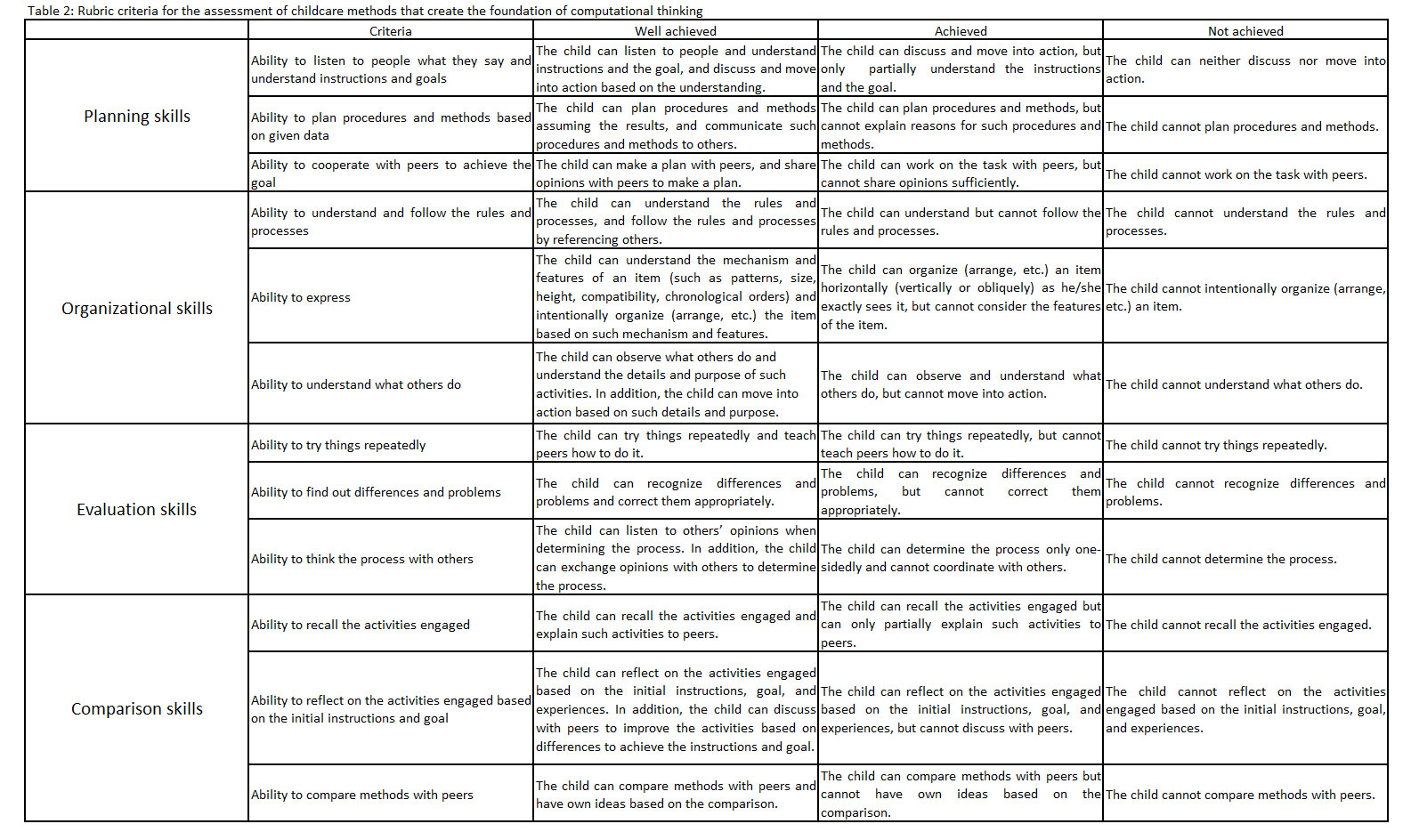
(1) Planning skills
The criteria for planning skills are the abilities "to listen to people what they say and understand instructions and the goal," "to plan procedures and methods based on given data," and "to cooperate with peers to achieve the goal." For example, when a child is asked to "choose some photos of an excursion he/she enjoyed most and show them to his/her parents," we will evaluate whether the child understands the goal of the task. To evaluate whether the child understands the goal and plans for it, we need to observe the child explaining the photos to the parents. Therefore, the criteria determined by the participant teachers include making a child understand a goal, plan for it, and cooperate with peers to achieve the goal.
(2) Organizational skills
The criteria for organizational skills are the abilities "to understand and follow the rules and processes," "to express," and "to understand what others do." When a child uses a programmable toy i.e. an edutainment toy to teach children programming (such as Bee-Bot and Code-a-Pillar Toys), the child needs to organize parts (such as choosing directional buttons which send Bee-Bot forward, back, left, and right, or connecting segments to make Code-a-Pillar go forward, back, left, and right) to achieve the goal. The child gradually understands the movement corresponding to each sign as the rules and combines these signs to express his/her intent. If the child works on the task with peers, he/she needs to observe the activities of peers and perform the next step. Therefore, the criteria for organizational skills include the ability to understand what others do.
(3) Evaluation skills
The criteria for evaluation skills are the abilities "to try things repeatedly," "to find out differences and problems," and "to think through the process with others." This is the evaluation of activities engaged by children. To evaluate such activities, children need to accurately understand what they did. They also need to discuss within a group and find out and correct problems. To evaluate the activities of a child, it is necessary to observe how he/she consults with peers. Therefore, the criteria for evaluation skills include the ability to think through the process with others.
(4) Comparison skills
The criteria for comparison skills are the abilities "to recall the activities engaged," "to reflect on the activities engaged based on the initial instructions and goal," and "to compare methods with peers." These criteria are for the comparison of the given goal with the activities to achieve the goal. To improve the activities, children need to recognize the task of their activities. Therefore, it is necessary to recall the activities engaged and compare methods with peers/initial goal.
Childcare practices that develop four skills associated with the foundation of computational thinking
Next, we addressed childcare practices that aimed to develop the "foundation of computational thinking" and assessed the development of children using a rubric. We again asked the kindergarten in Hyogo Prefecture mentioned previously for their cooperation. Childcare practices were implemented in two classes from May 2018 to February 2019. Each class had six groups, and each group was comprised of five or six children.
In this study, considering the aspect of a group-based experiment, we decided to use a programmable toy called Code-a-Pillar ("CAP"), which enabled us to easily observe how children would combine segments, and let children play with it instinctively. CAP is an edutainment toy with the shape of a caterpillar and has eight segments to control its movements (three go-straights, two right turns, two left turns, and one sound effect segment). Children can program a path for a CAP by configuring the segments and make it go forward, turn right or left, or play a sound. The use of a programmable toy is consistent with the case examples of programming education in kindergarten provided by Yamazaki, et al. (2017) and Oomori, et al. (2017) that "use contents and robots as educational tools."
The experiment was implemented in three stages, gradually increasing the level of difficulty. The initial stage was conducted from May to June 2018, the middle stage from September to October 2018, and the final stage from December 2018 to February 2019.
At the initial stage of the experiment using a CAP, we gave children a task to assemble a CAP in order to achieve a pre-set goal (Figure 1). In order to observe the order of segment combinations and compare the actual movement with the instructed movement, we let children use a paper passage corresponding to the segments of a CAP. I made this passage using drawing paper according to the range of movement consistent with the segments of a CAP. Children assembled their CAP through discussions within a group and moved it to check whether each movement had been achieved as planned. If there was any movement that was not achieved, they corrected the combination of the segments.
At the middle stage of the experiment using a CAP, we again gave children a task to assemble it to achieve a pre-set goal (Figure 2). This time, we let children use paper cards when they examined the order of segment combinations. The other procedures were the same as those of the initial stage.
At the final stage of the experiment using a CAP, we gave children a task to set their own goal and assemble their CAP to achieve it (Figure 3). We set some points where the CAP was not allowed to go through and let children examine the order of segment combinations using paper cards. The other procedures were the same as those of the initial and middle stages.
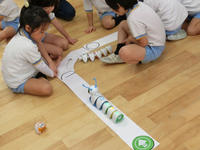
|
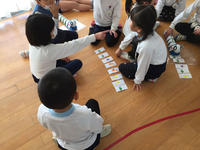
|
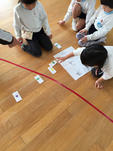
|
||
| Figure 1: Initial Stage | Figure 2: Middle Stage | Figure 3: Final Stage |
Effects of the experiment on the development of the foundation of computational thinking
Table 3 shows the rubric scores we obtained as a result of the childcare experiment described above. We conducted a one-way analysis of variance based on the results of the one-year experiment aiming to nurture the foundation of computational thinking, in order to examine the development of four skills associated with the foundation of computational thinking in the three stages (initial, middle and final stages).
As a result, we found significant differences in the rubric scores between the experiment stages. The scores indicate "F(2,22)=15.01, p<.01" for planning skills, "F(2,22)=27.15, p<.01" for organizational skills, "F(2,22)=8.07, p<.01" for evaluation skills, and "F(2,22)=6.72, p<.01" for comparison skills. Therefore, we further conducted multiple comparisons using the Bonferroni method for each skill to find out the timing of the occurrence of differences in the experimental stages.
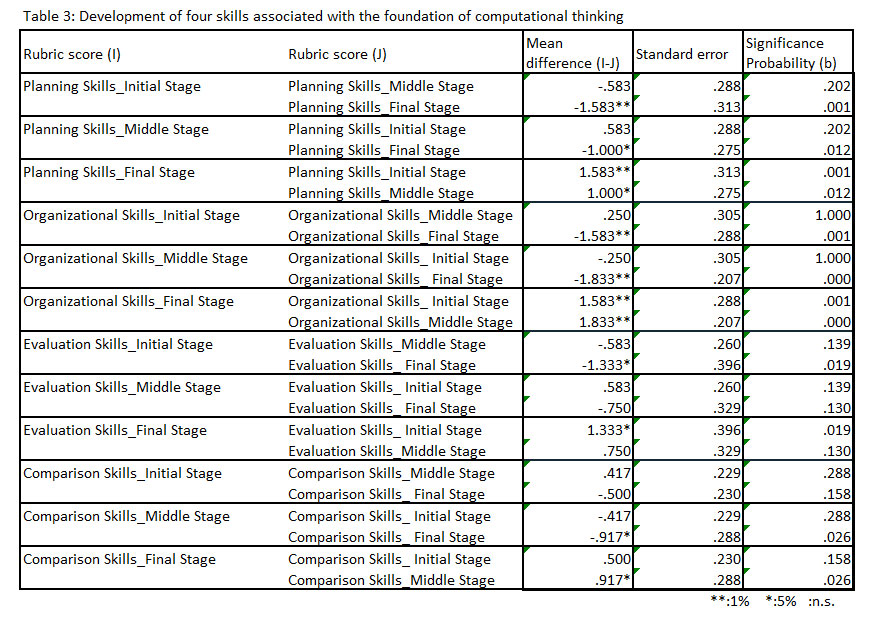
The results of multiple comparisons revealed the following aspects:
- For planning skills and organizational skills, there was a significant difference between the final stage and the other two stages at either the one percent or five percent level. This indicates that the continued experimental childcare practice contributed to the development of planning skills and organizational skills.
- For evaluation skills, there was a significant difference between the initial stage and the final stage at the five percent level. This indicates that the experimental childcare practice contributed to the moderate development of evaluation skills.
- For comparison skills, we found no significant contribution arising from the experimental childcare practice.
To summarize, this experiment successfully helped children think of planning and combination; therefore, we believe that this experiment developed the planning skills and organizational skills of children to some extent. For evaluation skills and comparison skills, however, as children became excessively fascinated by the movement of their CAP once they got it moving, we could not get them to recognize these skills sufficiently. Nevertheless, children corrected the order of segment combinations if their CAP did not move as planned, which indicates that they could identify problems. Therefore, it can be said that the evaluation skills of children were moderately developed as a result of the experiment. For comparison skills, since we let children play freely on a group basis under this experiment, we could not get them to sufficiently recognize the difference between the planned movement and the actual movement of their CAP. It is necessary to consider some specific procedures, for example, to record their planning at the initial stage, take photos or videotape the movement of their CAP, and let children compare the planned movement with the actual movement based on such photos or videos.
It is not easy to develop computational thinking in early childhood education and care. We hope to accumulate more research data by conducting childcare practices that may nurture computational thinking, such as this experiment, thereby contributing to the enhancement of programming education in early childhood education and care.
Note: This report was prepared by excerpting and modifying some portions from "Analysis on childcare that develops the foundation of computational thinking" and "Development of rubrics for the assessment of childcare that nurtures the foundation of computational thinking" compiled in the research report by the Japan Society for Educational Technology; "Analysis on the power of rubrics as tools for the assessment of childcare that develops the foundation of computational thinking" compiled in the national conference abstracts by the Japanese Society of Child Science; and "Use of media in early childhood education: importance of evidence" compiled in the 72nd annual conference report by the Japan Society of Research on Early Childhood Care and Education.
References:
- MEXT. (2019). Evaluation based on the understanding of children (March 2019). Retrieved from
http://www.mext.go.jp/a_menu/shotou/youchien/07121724/1296261.htm (as of May 31, 2019; in Japanese). - MEXT. (2016). Revised version of "How children should grow up by the end of early childhood" (Draft). Retrieved from
http://www.mext.go.jp/b_menu/shingi/chukyo/chukyo3/057/siryo/__icsFiles/afieldfile/2016/04/19/1369745_05.pdf (as of May 31, 2019; PDF file in Japanese). - MEXT. (2016). The concept of programming education in elementary school (summary). Retrieved from
http://www.mext.go.jp/b_menu/shingi/chousa/shotou/122/attach/1372525.htm (as of May 31, 2019; in Japanese). - MEXT. (2017). The Course of Study for Kindergartens. Froebel-Kan Co., Ltd.
- Nishioka, K. & Tanaka, K. (2009). Classes and evaluations that nurture the ability to apply knowledge and skills in junior high school: the challenges of performance and the suggestion of rubrics. Gakuji Publishing Co., Ltd.
- Noguchi, S. & Hotta, H. (2018a). Analysis on childcare that develops the foundation of computational thinking. JSET, 18(1): pp.1-8.
- Noguchi, S. & Hotta, H. (2018b). Development of rubrics for the assessment of childcare that nurtures the foundation of computational thinking. JSET, 18(2): pp.155-160.
- Noguchi, S., Hotta, H. & Matsu, H. (2018). Analysis on the power of rubrics as tools for the assessment of childcare that develops the foundation of computational thinking. Abstracts of the 15th national conference program by the Japanese Society of Child Science, pp.28.
- Oomori, Y., Isobe, M., Ueno, T., Ozaki, Y. & Yamazaki, S. (2017). A Study of Attainment Targets and Curriculum Management Related to Pupils' Physical and Mental Developmental Standard Levels in Elementary School Programming Education. Bulletin of Joetsu University of Education, 37(1), pp.205-215.
- Yamazaki, S., Yamamoto, T., Taguchi, H., Andoh, A., Ohtani, T., Oomori, Y., Isobe, M. & Ueno, T. (2017). The Proposition of Composition and Learning Attainment Targets Standards from Elementary to Upper Secondary Schools : Introduction Technology and Informatics Including IT Education as Coherent Subjects. Bulletin of Joetsu University of Education. 36(2), pp.581-593.



 Satoshi Nocuchi
Satoshi Nocuchi










